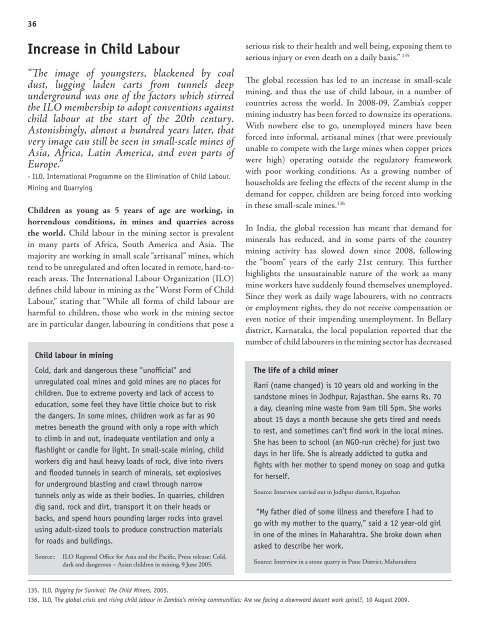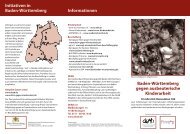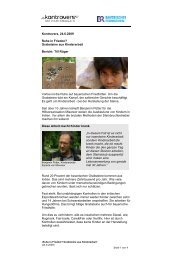35In several districts of Rajasthan, mine workers explained howthey had made financial sacrifices to send their children toschool, but after several years of attending local governmentschools, their children were still not able to read or write dueto the poor quality of the education provided and frequentteacher absences. One village in Jaisalmer district — where they had now given up on their government school and hadset up their own private school in the village. However, notall the parents were able to afford to send their children tothis school.In the mining areas of Bellary district, Karnataka, manyfamilies explained how their economic situation was sopoor that their children are forced to work rather thanattend school. With the decline in mining in the area dueto the economic downturn, some children have started toleave the mines and go back to school, but many others aresimply forced to look for alternative sources of income fortheir family. Some children continue to go to school in themorning and work in the afternoon, others are only seasonalworkers, whereas a large number continue to work as fulltimeemployees. 131 Girls were particularly likely to be outof school, as parents did not recognise the importance ofeducating them when “they will be married in a few yearsanyway.” 132 A number of families in Mariyammnahalli villagehave lost their farmland to mining. Therefore they have hadto take their children out of school and send them to work.The Don Bosco Shelter in Hospet explained that parents inthe mining areas are willing to send their children to school,but their economic situation was so bad that they are forcedto send their children to work in the mines just to fulfilltheir basic need for food. 133Existing legal, policy or programmeinterventions in educationrst mooted,the Right of <strong>Children</strong> to Free and Compulsory Education provi<strong>des</strong> for free and compulsory education for all childrenthe Act include mandated improvements to the quality ofeducation provided to all children. Whilst this is a positivestep in the right direction, it remains unclear how thislegislation will be implemented in the mining areas, wherelarge numbers of children are still forced to work ratherthan attend school, and where issues of displacement andmigration impact greatly on the child’s right to education.Sarva Shiksha Abhiyan is the government’s flagshipeducation programme aimed at achieving theuniversalisation of elementary education in India. However,the programme remains flawed in a number of ways. Forexample, the scheme’s policy of promoting parallel systemsof education has meant that children across the countryare being denied equal opportunity to a quality education.Although the scheme has achieved some success in termsof increasing enrollment figures, retention continues to bea huge problem, with as many as 31 per cent of childrendropping out before class V. This is particularly true in ruralbackward areas where mines and quarries tend to be located.In addition to this, the programme has failed to yet bring realimprovements to both the facilities and quality of educationprovided in the majority of these mining areas.Whilst the government is still failing to provide qualityeducation to all children in mining areas, there have been anumber of NGO initiatives aimed at children in these partsof the country. In Maharasthra, the NGO Santulan hasset up a number of Pashan Shala schools around the stonequarrying areas, which currently reaches 2,001 childrenscattered across five districts in Maharashtra, mostly thechildren of stone quarry workers who would otherwise beworking alongside their parents. These schools have nowbeen recognised by the state government. In Rajasthan, theorganisation MLPC has established a number of crèchefacilities around the mining areas in Jodhpur district toaddress the problem of mothers having to take their smallchildren to work with them. These crèches currently haveInternationally, efforts to reduce child labour and promoteeducation in mining areas have been limited or at leastnot widely documented. In Peru, a number of NGOs, theILO, the Government of Peru and the U.S. Departmentof Labour joined forces to launch an education project tocombat child labour in mining in the country. This projectaimed to remove children from gold mining and place themin quality school settings. 131. Interviews with female mineworkers, Bellary district, Karnataka, August 2009.132. Interviews with mineworkers, Bellary district, Karnataka, June 2009.133. Interview with director, Don Bosco Shelter, Bellary district, Karnataka, June 2009.Pamela Baldwin,134. The impact of education in Peru’s gold mining communities, 26 October 2006, http://ourworld.worldlearning.org/site/News2?page=NewsArticle&id=8467, uploaded: 5 November 2009.
36Increase in Child Labour“The image of youngsters, blackened by coaldust, lugging laden carts from tunnels deepunderground was one of the factors which stirredthe ILO membership to adopt conventions againstchild labour at the start of the 20th century.Astonishingly, almost a hundred years later, thatvery image can still be seen in small-scale mines ofAsia, Africa, Latin America, and even parts ofEurope.”- ILO, International Programme on the Elimination of Child Labour,Mining and Quarrying<strong>Children</strong> as young as 5 years of age are working, inhorrendous conditions, in mines and quarries acrossthe world. Child labour in the mining sector is prevalentin many parts of Africa, South America and Asia. Themajority are working in small scale “artisanal” mines, whichtend to be unregulated and often located in remote, hard-toreachareas. The International Labour Organization (ILO)defines child labour in mining as the “Worst Form of ChildLabour,” stating that “While all forms of child labour areharmful to children, those who work in the mining sectorare in particular danger, labouring in conditions that pose aChild labour in miningCold, dark and dangerous these "unofficial" andunregulated coal mines and gold mines are no places forchildren. Due to extreme poverty and lack of access toeducation, some feel they have little choice but to riskthe dangers. In some mines, children work as far as 90metres beneath the ground with only a rope with whichto climb in and out, inadequate ventilation and only aflashlight or candle for light. In small-scale mining, childworkers dig and haul heavy loads of rock, dive into riversand flooded tunnels in search of minerals, set explosivesfor underground blasting and crawl through narrowtunnels only as wide as their bodies. In quarries, childrendig sand, rock and dirt, transport it on their heads orbacks, and spend hours pounding larger rocks into gravelusing adult-sized tools to produce construction materialsfor roads and buildings.Source::ILO Regional Office for Asia and the Pacific, Press release: Cold,serious risk to their health and well being, exposing them toserious injury or even death on a daily basis.” 135The global recession has led to an increase in small-scalemining, and thus the use of child labour, in a number of mining industry has been forced to downsize its operations.With nowhere else to go, unemployed miners have beenforced into informal, artisanal mines (that were previouslyunable to compete with the large mines when copper priceswere high) operating outside the regulatory frameworkwith poor working conditions. As a growing number ofhouseholds are feeling the effects of the recent slump in thedemand for copper, children are being forced into workingin these small-scale mines. In India, the global recession has meant that demand forminerals has reduced, and in some parts of the countrymining activity has slowed down since 2008, followingthe “boom” years of the early 21st century. This furtherhighlights the unsustainable nature of the work as manymine workers have suddenly found themselves unemployed.Since they work as daily wage labourers, with no contractsor employment rights, they do not receive compensation oreven notice of their impending unemployment. In Bellarydistrict, Karnataka, the local population reported that thenumber of child labourers in the mining sector has decreasedThe life of a child minerRani (name changed) is 10 years old and working in thesandstone mines in Jodhpur, Rajasthan. She earns Rs. 70a day, cleaning mine waste from 9am till 5pm. She worksabout 15 days a month because she gets tired and needsto rest, and sometimes can’t find work in the local mines.She has been to school (an NGO-run crèche) for just twodays in her life. She is already addicted to gutka andfights with her mother to spend money on soap and gutkafor herself.Source: Interview carried out in Jodhpur district, Rajasthan“My father died of some illness and therefore I had togo with my mother to the quarry,” said a 12 year-old girlin one of the mines in Maharahtra. She broke down whenasked to <strong>des</strong>cribe her work.Source: Interview in a stone quarry in Pune District, Maharashtra135. ILO, Digging for Survival: The Child Miners, 2005.136. ILO, The global crisis and rising child labour in Zambia’s mining communities: Are we facing a downward decent work spiral?, 10 August 2009.
- Page 2 and 3: India’s Childhood in the "Pits"A
- Page 4 and 5: iiiAcknowledgementsThis report, cal
- Page 6 and 7: Table of ContentsAbout the Study 3M
- Page 8 and 9: 4List of states and districts visit
- Page 10 and 11: 6However, closer observation of the
- Page 12 and 13: 8In addition, almost all work perfo
- Page 14 and 15: 10ImpactsChildren are affected dire
- Page 16 and 17: 12is mandatory and this must be ens
- Page 18 and 19: 15National OverviewMining has impac
- Page 20 and 21: 17Table 1.2: Number of illegal mine
- Page 22 and 23: 19Table 1.3: Key indicators in mini
- Page 24 and 25: 21migrate to plain areas or are con
- Page 26 and 27: 23had no land to start with and wor
- Page 28 and 29: 25Although there is no data to show
- Page 31 and 32: 28Pollution Control Board have reve
- Page 33 and 34: 30Accidents from blasting activitie
- Page 35 and 36: 32abdominal pains, arthritis, jaund
- Page 37: 34because companies can pay them le
- Page 41 and 42: 38“My name is Sudeep. I am workin
- Page 43 and 44: 40Working conditions in the informa
- Page 45 and 46: 42Efforts to address child labour i
- Page 47 and 48: 44the situation of children living
- Page 49 and 50: 47KarnatakaState OverviewThe popula
- Page 51 and 52: 49population of Bellary continues t
- Page 53 and 54: 51Kolar Gold Fields: The Golden Gra
- Page 55 and 56: 53and returning by the last train t
- Page 57 and 58: 55Bellary: Children Behind the Iron
- Page 59 and 60: 57The Condition of Children Living
- Page 61 and 62: 59In Kallali village, where there a
- Page 63 and 64: 61The anganwadi inSultanpura showed
- Page 65 and 66: 63Rangamma’s story: stone quarryi
- Page 67 and 68: 66deaths in 2004 to 174 deaths in 2
- Page 69 and 70: 68Nashik district: Key factsTotal p
- Page 71 and 72: 70Basic housing and sanitation are
- Page 73 and 74: 72Table 2.03: Santulan Pashan Shala
- Page 75 and 76: 74Table 2.05: Bal Shikshan Kendras
- Page 77 and 78: 76Table 2.07: Socio-economic distri
- Page 79 and 80: 79RajasthanState OverviewRajasthan,
- Page 81 and 82: 81Most worryingly, there has been n
- Page 83 and 84: 83Jaisalmer district: Key factsTota
- Page 85 and 86: 85According to their plans, the pri
- Page 87 and 88: 87been attending government schools
- Page 89 and 90:
89As well as malaria, the most comm
- Page 91 and 92:
91land as more and more is acquired
- Page 93 and 94:
93Madhya PradeshState OverviewThe t
- Page 95 and 96:
95Panna district: Key factsTotal po
- Page 97 and 98:
97Impact of Displacement andResettl
- Page 99 and 100:
99but a teacher is sent from the pr
- Page 101 and 102:
101or migrate to Delhi, Kanpur, Jha
- Page 103 and 104:
103ChhattisgarhState OverviewChhatt
- Page 105 and 106:
105It is hard to gauge the state’
- Page 107 and 108:
107The case study was done in Raiga
- Page 109 and 110:
109Table 2.10 gives the government
- Page 111 and 112:
111born either weak or with physica
- Page 113 and 114:
113EIA for Jindal coal mine in Chha
- Page 115 and 116:
116state, and by May 2007, had reha
- Page 117 and 118:
118pass through the town loaded wit
- Page 119 and 120:
120which is then purchased by petty
- Page 121 and 122:
122Water: A Looming Crisis for Wome
- Page 123 and 124:
124but not the actual economic live
- Page 125 and 126:
127OrissaState OverviewOrissa has a
- Page 127 and 128:
129aged between 6 and 14 years in t
- Page 129 and 130:
131cent from the previous year. 251
- Page 131 and 132:
133Rayagada district: Key factsTota
- Page 133 and 134:
135opened up in Damanjodi, Orissa.
- Page 135 and 136:
137from SC community and rest are O
- Page 137 and 138:
139Child LabourChild labour is a cl
- Page 139 and 140:
141loading one basket of the ore in
- Page 141 and 142:
143drop-out rate and there are only
- Page 143 and 144:
145reason, according to them, for s
- Page 145 and 146:
147UAIL earlier a joint venture of
- Page 147 and 148:
149Table 2.24: Some demographic det
- Page 149 and 150:
151Table 2.27: Some figures regardi
- Page 151 and 152:
153Orissa including Kasipur is well
- Page 153 and 154:
155Table 2.28: Details of some of t
- Page 155 and 156:
157Table 2.30: Village data from Ce
- Page 157 and 158:
159regularly, so the children go fo
- Page 159 and 160:
161the Joda and Barbil region with
- Page 161 and 162:
163Abuse of Children in the Media b
- Page 163 and 164:
166from TB in the state and the sta
- Page 165 and 166:
168Cuddapah district: Key factsTota
- Page 167 and 168:
170Problems of Mine Workers’ Chil
- Page 169 and 170:
172their parents and were driven by
- Page 171 and 172:
174want to see their children sucke
- Page 173 and 174:
176Kids Being Trafficked from N.E.
- Page 175 and 176:
179Summary and RecommendationsAlmos
- Page 177 and 178:
181Health problems of children livi
- Page 179 and 180:
studies here can help evoke a glimm
- Page 181 and 182:
185addressed to include all mining
- Page 183 and 184:
187made by the monitoring committee
- Page 185 and 186:
Part IVAppendix- Our Experience wit
- Page 187 and 188:
192Table 2.44 presents some of the
- Page 189 and 190:
194Goachildren in Cuddalore distric
- Page 191 and 192:
1965. Schools established, number o
- Page 193 and 194:
198ConclusionsThe RTI Act is intend
- Page 195 and 196:
Maharashtra199The table shows that
- Page 197 and 198:
201Data of children’s education i
- Page 199 and 200:
203Data of drop-out children in Bel
- Page 201 and 202:
206Human Development Index (HDI): C
- Page 203:
!!"#






